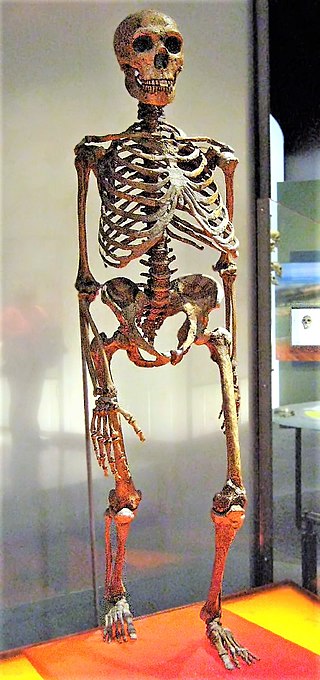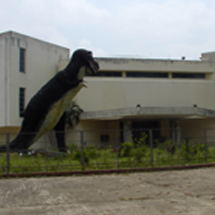হোমোসেপিয়েন্স (নিয়াডার থ্যালেনসিস)
ডুসেল ডর্ফ শহরের নিয়েনডার জর্জের ফেল হোপার গুহা থেকে ১৮৫৬ সালে নিয়েনডারথ্যাল মানুষের ফসিল আবিস্কৃত হয়। ১৮৩০ সালে বেলজিয়ামের গ্রোটেস ডি'ইঙ্গিসে ডাচ প্রকৃতিবিদ ফিলিপ-চার্লস শামার্লিংয়ের দ্বারা আবিষ্কৃত প্রথম নিয়ানডারথালটি "অ্যাঙ্গিস ২ (একটি খুলি) রয়ে গেছে, তবে তিনি মনে করেছিলেন যে এটি একটি জীবাশ্ম আধুনিক মানুষের খুলি। ১৮৪৮ সালে, ফোর্বস কোয়ারি থেকে জিব্রাল্টার সায়েন্টিফিক সোসাইটির কাছে তাদের সেক্রেটারি লেফটেন্যান্ট এডমন্ড হেনরি রিনি ফ্লিন্ট উপস্থাপন করেছিলেন, তবে এটি একটি আধুনিক মানুষের খুলিও বলে মনে করা হয়েছিল। ১৮৫৬ সালে স্থানীয় স্কুলশিক্ষক জোহান কার্ল ফুহল্রোট নিয়ানডার ভ্যালির ক্লেইন ফিল্ডোফার গ্রোটের হাড়কে চিনতে পেরেছিলেন - নিয়ান্ডারথাল ১ (হোলোটাইপ নমুনা) - যা আধুনিক মানব থেকে পৃথক এবং সেগুলি জার্মান নৃতত্ত্ববিদ হারম্যান স্কাফাউসেনকে ১৮৫৭ সালে অধ্যয়ন করার জন্য দিয়েছিল। এতে ক্রেনিয়াম রয়েছে, হাড়, ডান হাত, বাম হিউমারাস এবং উলনা, বাম ইলিয়াম (হিপ হাড়), ডান কাঁধের ফলকের অংশ এবং পাঁজরের টুকরো। চার্লস ডারউইনের অন ওরিজিন অফ স্পিসির অনুসরণ করে ফুহল্রোট এবং শ্যাফাউসেন যুক্তি দিয়েছিলেন যে হাড় একটি প্রাচীন আধুনিক মানব রূপকে উপস্থাপন করে; একজন সোশ্যাল ডারউইনবাদী, শ্যাফাফাউসন বিশ্বাস করেছিলেন যে মানুষ বর্বর থেকে সভ্যতে রৈখিকভাবে অগ্রগতি করেছিল এবং তাই এই সিদ্ধান্তে পৌঁছেছিল যে নিয়ান্ডারথালরা বর্বর গুহাবাসী ছিল। শারীরিক গঠনে এরা বর্তমান যুগের মানুষ থেকে আলাদা । তাদের মাথার খুলি বেশ বড় ছিল এবং মগজ বর্তমান যুগের মানুষের মত। এরা ফ্রান্স , হাঙ্গেরী , পশ্চিম এশিয়া ও সোভিয়েত ইউনিয়নের বিভিন্ন অঞ্চলে বিস্তৃত ছিল।

In 1856, it is discovered from the cave of Jorge Fel Neander in the Dusseldorf city.
The first Neanderthal remains—Engis 2 (a skull)—were discovered in 1829 by Dutch naturalist Philippe-Charles Schmerling in the Grottes d'Engis, Belgium, but he thought it was a fossil modern human skull. In 1848, Gibraltar 1 from Forbes' Quarry was presented to the Gibraltar Scientific Society by their Secretary Lieutenant Edmund Henry Rene Flint, but was also thought to be a modern human skull. In 1856, local schoolteacher Johann Carl Fuhlrott recognised bones from Kleine Feldhofer Grotte in Neander Valley—Neanderthal 1 (the holotype specimen)—as distinct from modern humans and gave them to German anthropologist Hermann Schaaffhausen to study in 1857. It comprised the cranium, thigh bones, right arm, left humerus and ulna, left ilium (hip bone), part of the right shoulder blade, and pieces of the ribs. Following Charles Darwin's On the Origin of Species, Fuhlrott and Schaaffhausen argued the bones represented an ancient modern human form; Schaaffhausen, a social Darwinist, believed that humans linearly progressed from savage to civilised, and so concluded that Neanderthals were barbarous cave-dwellers.
In morphological structure, they are separate from the present human being. Their skull was too large & brain was as like as present human being. They were distributed in different region of France, Hanggary, West-Asia & Soviet Union.


.jpg)






















